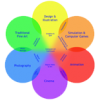This thesis proposes that art created through the agency of a computer may be termed “Computer Art” and distinguished from all other forms of visual art by its computational basis. Computer Art is a significant development in the visual arts because the computer operates simultaneously as medium, tool and context, in addition to its organisational and interactive elements. The image-space described using software frees artists from the restrictions of physical media by providing a dynamic non-material environment, whose potentials may be realised in the resulting artwork. The digital basis of computer artwork raises questions about the uniqueness of an “original” in this branch of visual art. Similarly, the dynamic nature of this medium makes it difficult to realise the artwork as a purely physical, static object, and its lack of permanence challenges accepted ideas of the preservation and propagation of artwork. Because the computer provides the image-space and the tools for image-making, it can be seen as a platform for art in the same way it has become a platform for architecture, music and design. It has subsumed the physical act of drawing into the conventions of its graphical user interface; the movement of the mouse results in a series of computational processes rendering a line on the screen. This physical activity creates a digital image which may be manipulated and changed in ways previously inconceivable for physical media. Thus the computer extends the intellectual substrate of the creative act. Computer Art is presented as a series of technological, artistic and theoretical developments that, taken together, comprise this new field of visual art. Previous investigations of Computer Art have sought to explain it as a more limited phenomenon, often identifying only one of its manifestations as “Computer Art” and disregarding others. The wider question of the computer’s contribution to art has not been fully explored. This has resulted in definitions based on particular practices of using the computer, as if “Computer Art” were limited to one image-making technique. Such definitions are more concerned with the process of making Computer Art. By contrast, the definition put forward here attempts to account for the artist’s experience of using the computer, and the computer’s own contribution to the artwork. In the course of this study, I will consider how Computer Art has been approached over the past fifty years, which artists have utilised it most effectively, and how it is gradually distinguishing itself as an artform in its own right. Computer Art has always attracted great expectation, yet it still seems to be in a formative stage. The period examined in this thesis runs from 1950 to 2000, with additional material from the early twentieth century. The year 1950 has been previously identified as the start of “Computer Art” proper, with Ben Laposky’s use of an oscilloscope to create Lissajous figures. By dealing with pertinent examples of mechanised art from before 1950, I hope to show that Laposky, John Whitney and other early pioneers came to the computer with a sense of what machines could achieve in this field. The year 2000 has been adopted as a convenient break-off point, allowing for fifty years’ development. The 1960s witnessed a great fluorescence of computer-related artforms that subsequently declined in the 1970s. However, the progress of imaging technology in allied fields such as film special effects and animation, combined with the widespread availability of personal computers from the mid-1980s, ensured that artists once again took an interest in the computer. Thus the period from the late 1970s onwards is, in many respects, a very different “Computer Art”, but both periods are united by certain shared concerns centring on the computer. Jasia Reichardt noted in 1971 that great works of Computer Art have yet to appear and this artform’s principal interest lies in the opening of new frontiers.[1] Some may believe this is still the case, but I contend that so long as Computer Art is valued only for its potentials, its full realisation will never take place and it is doomed to remain embryonic. Computer artworks should instead develop alongside long-term artistic attempts to investigate the computer as a platform for art. The most successful computer artists have followed this approach. (via 2. Hypothesis « Computer Art Thesis
)
